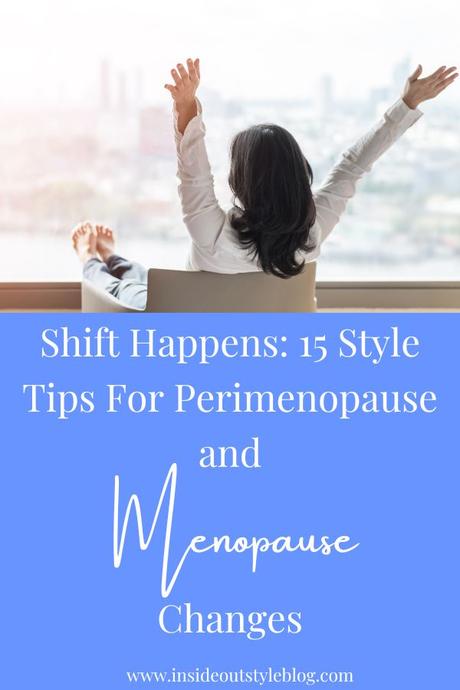



Menopause which is the cesation of menstruation (and Perimenopause, which is the period before that often lasts for around 10 years) are something I knew very little about until I started going through them, and even then there were a bunch of strange symptoms that have happened to me over the past 15 years that I now know are actually related to menopause, from aching joints and some forgetfulness (I thought it was just getting old) to itchy toes and other strange skin sensations for no reason, along with ones I did know about (worsening sleep and night sweats, which for someone who is chronically cold, that’s been a big change, to the chin hairs that I’m constantly plucking and weight gain to a cervix that prolapsed).
I felt that I’ve gotten off reasonably lightly as I haven’t had the brain fog and depression that many women suffer, nor have I had any daytime hot flushes, yet recently after talking to my doctor about a few symptoms that are affecting my quality of life (I hadn’t realised that the migraines I’ve had over recent years were related), I decided to try HRT (hormone replacement therapy) patches. Now I’d heard in the past about how HRT was supposed to increase your risk of breast cancer, but in fact, much of the information about that study, and the kind of HRT that was being given (estrogen from pregnant horse urine prescribed in oral format at much higher rates, rather than what I’m taking, which is estrogen from yams taken via skin patch at much lower doses, which is the kind that our body was producing itself when pre-menopausal) was not the same, and in fact, I learned today listening to this really interesting podcast interview with Dr Louise Newson, who is a world-leading expert on menopause, that there are actually a whole load of benefits of taking HRT and the supposed increase in breast cancer rates was wildly over reported (and the facts were ignored for a sensational media story), which scared most doctors away from prescribing HRT.
As someone whose paternal grandmother died from a stroke at age 55, with a family history of high blood pressure and cholesterol, learning that taking HRT can actually reduce the risks of these as well as dementia (which also seems to run in my family on both my mother’s and father’s sides) makes me feel much better about my decision as estrogen has a protective effect on bones as well as your cardiovascular system (and did you know that death within 1 year of a hip fracture sits at 21%, and osteoporosis is a common reason why falls cause hip fractures whilst death within 5 year of diagnosis from breast cancer is currently sitting at around 8%). What I find encouraging is that in women who start HRT earlier (than in that WHI trial that was the one with the horse urine-derived HRT) their risk of coronary disease and all-cause mortality declines.
What is sad, is that my GPs, who are lovely but don’t, I’m sure like most GPS, haven’t had much training in menopause/perimenopause symptoms, and too, had been discouraged from offering HRT, and when they do, as I got mine to prescribe me, it seemed they wanted the lowest dose for the shortest time as the early 2000s fear-mongering still lingers.
Now I’m not a doctor nor is this article medical advice, but if you’re like me and have been thinking that you should avoid it at all costs, HRT, it may be worth you going to speak to a qualified medical professional who is a menopause specialist (your GP may not be the best person as they may not have the training and be up on the current research) to help you find the best solution for you.
15 Personal Style Tips for Perimenopause and Menopausal Women
If You Suffer from Brain Fog or Feeling Low, Tiredness
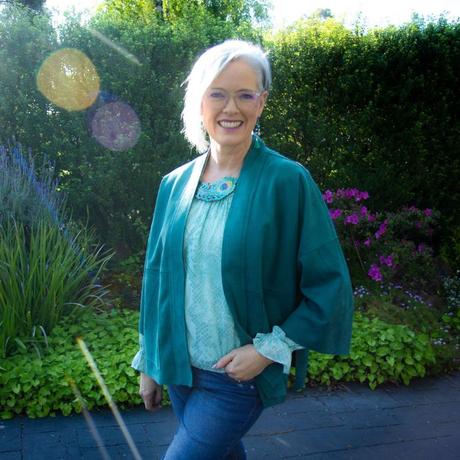
Loose layers may be more comfortable than tight ones
1, Go-to outfits that you’ve photographed (so you know exactly what they are and don’t have to think when getting dressed) can be great to take the stress out of your morning and have you feeling great all day. When you’re not feeling fabulous, knowing that your outfits work, rather than making you feel worse, can assist you in getting on with your day.
2. Wear a color you love as it’ll help you feel better, plus wearing color indicates confidence and other people also respond better to those wearing color than all neutrals (particularly if that neutral is black). Colour can lift your mood and the moods of those around you. Embrace its power. If you’re not sure what colours suit you today (hair color changed since you were 20?) then investing in a colour analysis will give you the tools you need to make great choices.
3. Wear what you love, live in the moment, and don’t keep your good clothes for special occasions, as fashions change and you want to enjoy them and get value from them while they’re in fashion. Keeping your clothes for “good” is a waste, wear them and enjoy them.
If Menopause Has Change Your Body Shape
4. As hormones disappear, weight shifts from hips and thighs onto tummies. Get to know what works for your new shape, rather than having a go at yourself. You may need to reassess your body shape (check out my body shape calculator quiz and download your body shape bible to give you the good oil and all the tips on flattering the figure you have today), and learn how to dress a new body shape that’s different. Give yourself some grace and space, this takes time and effort and you may not be feeling like you’ve got that (don’t we all want instant results?) but it’s a natural stage of life and you’re not alone in what you’re going through. I’ve got heaps of tips here on the blog on how to hide your tummy so that you can still look stylish even though right now you may be feeling like it’s all too hard.
5. You may find that now you want everything to skim past your belly and avoid defined waistlines, instead going for just under your bust with empire styles that then drape past your tummy.
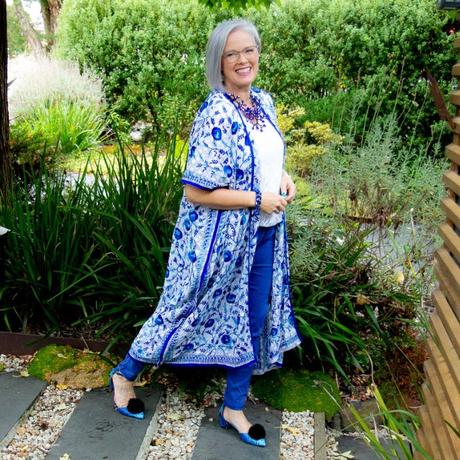
Lightweight layers cover all sorts
6. A third piece such as a blazer or jacket can also add instant style to your outfit (and can be removed if needed). Plus sometimes a more structural piece like a jacket helps to hide the weight that’s moved onto your torso. In summer lightweight kimono or dusters are great items to layer if it’s not completely scorching and too hot to wear much at all.
7. Look for summer tops with built-in detail, such as interesting textures, construction or patterns if you tend to run hot.
8. Fabrics with stretch may also make you feel more comfortable particularly if you bloat or your weight fluctuates.
If You Have Hot Flushes
9. Layers are essential . You want to be able to take off outer layers if you get too hot then put them back on when you cool down. Or maybe you’re like my mother who was just hot all the time (I remember one particular winter where she wore shorts and a short-sleeved blouse every day, if you ask her she says she never had a hot flush, she just ran hot that whole time).
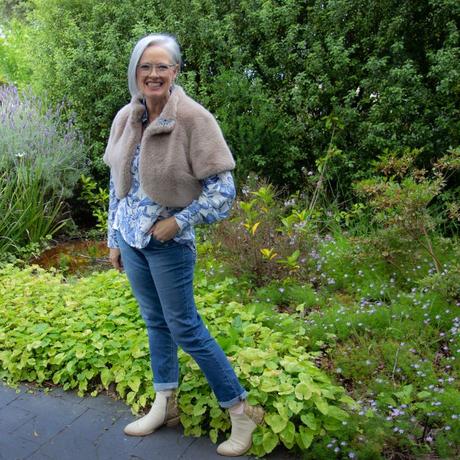
10. Opt for natural fibres (cotton, linen, bamboo, rayon, wool) that breathe and don’t hold sweat against your body which will make you uncomfortable. Polyester and cotton blends also work well. Though 100% polyester or acrylic which will make you sweat and feel like you’re wrapped in a plastic bag. High tech sports fabrics are made from synthetics (nylon/polyester) but are designed to wick sweat away from your body and help you stay cool.
11. You may prefer more flowy styles that don’t hold heat into your body.
12. How to accessorize when necklaces leave you feeling hot? It’s time for earrings and brooches to make a comeback and provide that all-important focal point in your portrait area.
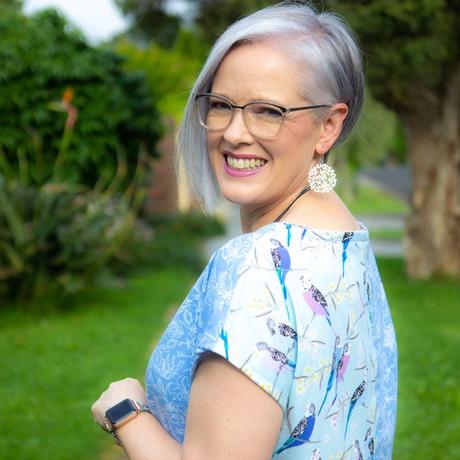
If You Have Sensitive Skin
13. You may get the itchy scratchies or your skim may just feel more sensitive, so go for softer fabrics and stretch fabrics, and cut out the labels if they irritate you. When you try on clothing make sure the seams are well finished so they aren’t scratchy or irritating either.
If Your Hair is Thinning, Your Skin is Drying Out and You’re Always Discovering New Chin Hairs
14. You may want to discuss hairstyle options with your hairdresser if your hair is thinning to find one that works with what you have rather than continuing on with the hairstyle you’ve been wearing. A new style can give you new confidence.
15. I noticed my skin drying out (I’ve always had super moist skin) which has called for a change in moisturizers and other skin products. And then I have an endless battle with chin hairs, so now I keep a pair of tweezers in the bathroom, on my desk and in my car, as well as in my handbag, as I find it infuriating if I discover a newly sprouting chin hair and I can’t get rid of it immediately!
If you’re struggling with your new body, colouring and style and all the changes that the peri/menopausal years bring with it, I’d love to invite you to join my 7 Steps to Style program, as learning what works now (rather than what did work) can help you feel more confident again and get you back on the right track, plus I’ve got so many lovely women who too are in this stage of life who get what you’re going through and the connection and community is inspiring.
Menopause (and Perimenopause) Resources
The Imperfects Podcast with Dr Louise Newson
It’s Menopause by Kaz Cooke
